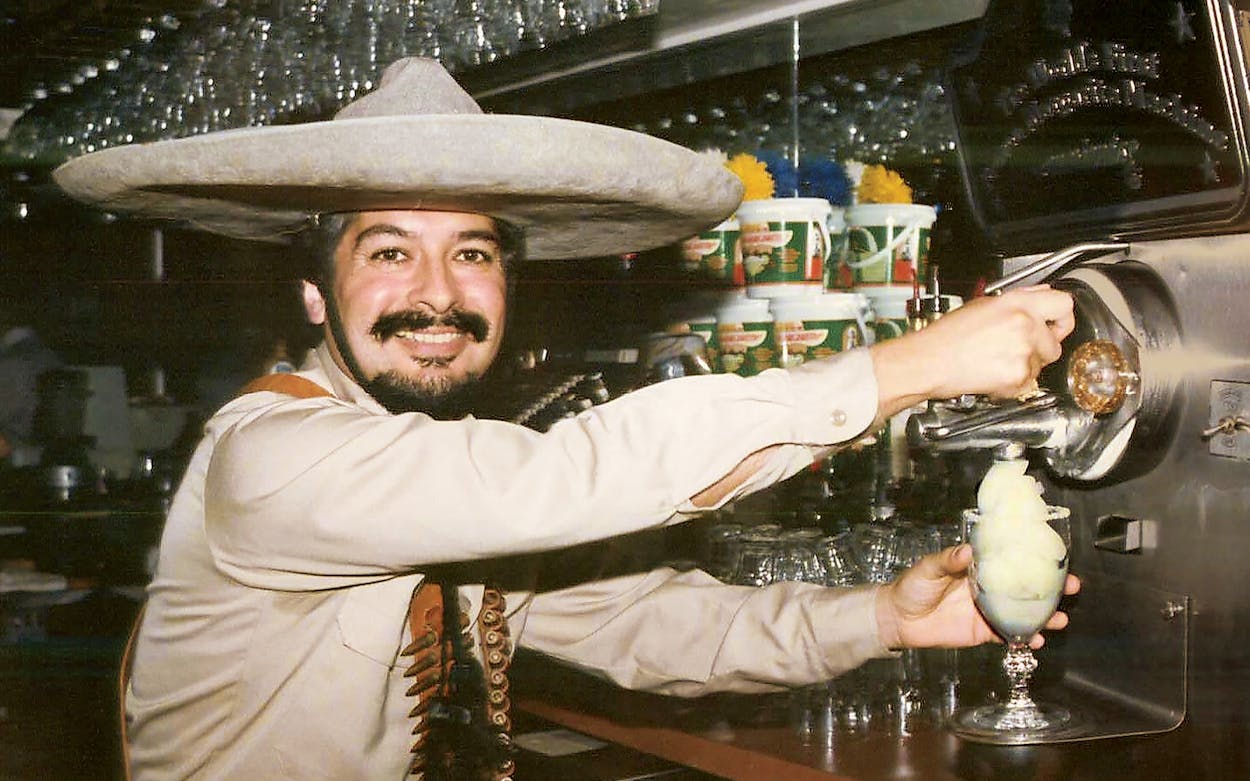I was born in 1944 in Little Mexico, which was located just north of downtown Dallas. At that time, the forties and earlier, Mexican restaurants often had a lot of Anglo customers. They would serve chicken-fried steaks, fried chicken, spaghetti and meatballs, mashed potatoes, green beans, dinner rolls. Of course they would also offer basic Mexican food like enchiladas with chili gravy and tamales, but you couldn’t charge very much—it was expected to be cheap. And it wasn’t called Tex-Mex then, just Mexican food. Actually, some Anglos thought the term “Mexican” was offensive, so they would say, “Oh, we just love Spanish food.”
Dallas’s Mexican population was small, but it produced two influential chains, El Fenix (founded in 1918) and El Chico (in 1940). The two still exist. Martinez also learned about food from both sides of his family.
“I have fond memories of going to El Fenix and seeing the tortilla ladies making flour tortillas by hand. They wore colorful costumes, and if you were a kid, you could go up and watch and they’d give you a small ball of uncooked masa. You could eat it or take it back to the table and play with it—roll it into a little snowman or something. That was educational for the Anglo kids. The tortilla ladies were sharing a handmade product that was part of their culture.
I grew up with my grandmother’s cooking. She was from Kaufman, in East Texas, and my great-grandmother made tamales at the Kaufman County Fair. My father, who worked as a restaurant manager, was from San Antonio. He was a good cook and a good taster. He knew those San Antonio flavors, and his chili con carne was once sold at the State Fair of Texas. I use that recipe to this day. I guess my food is a combination of East Texas style and San Antonio style. Mexican food wasn’t as popular back then as it is now. In the sixties and seventies, a lot of Anglos ate Mexican food once a month. Then it got to be twice a month.
When Martinez decided to open his first restaurant in 1971, when he was in his twenties, he wanted to make it as upscale as he could on a limited budget. He applied for a Small Business Administration loan more than once.
I was turned down by eleven banks before I finally got a loan. Every loan officer I talked to told me the same thing: “Oh, we did a restaurant loan back in 1952 and we lost our ass. We’re never doing that again.” Finally the president of one bank did it because he liked me. He liked the ideas and thought it would be good for the bank—they had a lot of minority depositors but hadn’t made any minority loans. So I got an SBA loan for $100,000, plus I had $500 from selling all my musical instruments and equipment from the band I had been in. I leased a space in Old Town in the Village, which was a new shopping center at the time. There were a lot of high-earning singles that lived there. When I was in the band, I had learned a lot about lighting and makeup and atmosphere at nightclubs and country clubs and parties. I made Mariano’s Mexican Cuisine the total package. When you walked in, it looked like an outdoor patio in Mexico with mountains in the background. I used blue lighting for the moonlight. There was a tree trunk inside that cast shadows to help with the realism. And there was piped-in music.
I didn’t have a lot of money so we were inventive. I found a carpet place selling shag carpet pieces in different colors and we put those in the cantina. (When tortilla chips fell on the carpet, we used garden rakes to get them out.) Then we took the cardboard tubes from the carpet rolls, cut them in half lengthwise, and painted them to look like weathered Mexican roof tiles.
Besides elevating the ambience, he wanted to elevate the food too.
I didn’t cut corners in the kitchen. The original recipes from my grandmother were pretty basic—some just said “handful of this and that,” so the results depended on the size of your hand. We measured the ingredients exactly. And we didn’t just buy “chili meat.” I asked my dad what’s the best mix. He said 80 percent lean, 20 percent fat. And we used Wisconsin cheddar that had been aged between thirty and ninety days. I chose the name Mariano’s Mexican Cuisine, not “café” or “casita.” People said, “Cuisine? That’s kind of a French word, isn’t it?” Mariano’s was the most expensive Mexican restaurant in Dallas when it opened. Customers would tell me, “When we go to El Chico or El Fenix, we take the kids and go early. When we go to Mariano’s, we get a babysitter, we have frozen margaritas in the cantina, an elegant dinner in the dining room, and then we go back to the cantina for flaming coffee or after-dinner drinks.” We helped break the image of cheap Mexican food in Dallas.
Mariano Martinez currently owns five locations of two restaurant concepts—Mariano’s Hacienda and La Hacienda Ranch—in Addison, Colleyville, Dallas, and Frisco. This interview has been edited for length and clarity.








